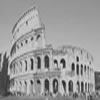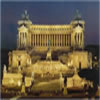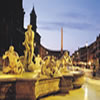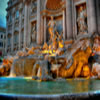


 COLOSSEUM
COLOSSEUM
The Colosseum or Roman Coliseum, originally the Flavian Amphitheatre (Latin: Amphitheatrum Flavium, Italian Anfiteatro Flavio or Colosseo), is an elliptical amphitheatre in the center of the city of Rome, Italy, the largest ever built in the Roman Empire. It is one of the greatest works of Roman architecture and Roman engineering.
Occupying a site just east of the Roman Forum, its construction started between 70 and 72 AD under the emperor Vespasian and was completedin 80 AD under Titus, with further modifications being made during Domitian's reign (81-96)
 PIAZZA VENEZIA
PIAZZA VENEZIA
PThe Piazza Venezia is a piazza in central Rome. It takes its name from the adjacent Palazzo Venezia.
 PIAZZA NAVONA
PIAZZA NAVONA
Piazza Navona is a city square in Rome, Italy. It follows the plan of an ancient Roman circus, the 1st century Stadium of Domitian, where the Romans came to watch the agones ("games"): It was known as 'Circus Agonalis' (competition arena). It is believed that over time the name changed to 'in agone' to 'navone' and eventually to 'navona'.
Defined as a public space in the last years of 15th century, when the city market was transferred to it from the Campidoglio, the Piazza Navona is now the pride of Baroque Roman art history. It features sculptural and architectural creations by Gian Lorenzo Bernini, whose famous Fontana dei Quattro Fiumi (Fountain of the Four Rivers, 1651) stands in the center; by Francesco Borromini and Girolamo Rainaldi, who designed the church of Sant'Agnese in Agone; and by Pietro da Cortona, who painted the galleria in the Pamphilj palace.
 TREVI FOUNTAIN
TREVI FOUNTAIN
The Trevi Fountain is a fountain in the Trevi rione in Rome, Italy. Standing 25.9 meters (85 feet) high and 19.8 meters (65 feet) wide, it is the largest Baroque fountain in the city.In 1629 Pope Urban VIII, finding the earlier fountain insufficiently dramatic, asked Gian Lorenzo Bernini to sketch possible renovations, but when the Pope died, the project was abandoned. Bernini's lasting contribution was to resite the fountain from the other side of the square to face the Quirinal Palace (so the Pope could look down and enjoy it). Though Bernini's project was torn down for Salvi's fountain, there are many Bernini touches in the fountain as it was built.
 PANTHEON
PANTHEON
The Pantheon is a building in Rome, originally built by Marcus Agrippa as a temple to all the gods of Ancient Rome, and rebuilt in the early 2nd century AD. The intended degree of inclusiveness of this dedication is debated. The generic term pantheon is now applied to a monument in which illustrious dead are buried. It is one of the best preserved of all Roman buildings. It has been in continuous use throughout its history. Since the 7th century, the Pantheon has been used as a Roman Catholic church dedicated to "St. Mary and the Martyrs".